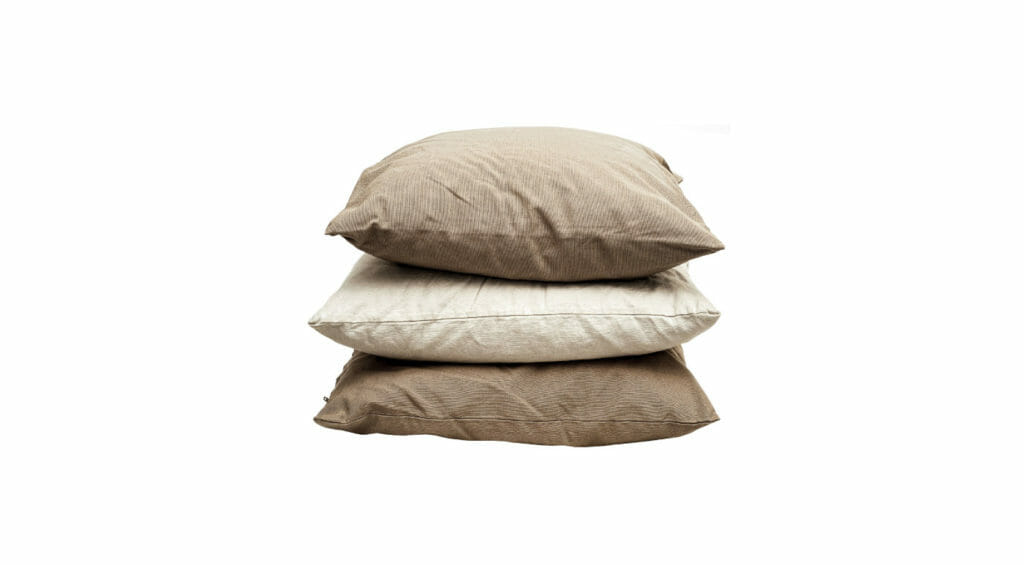
If you struggle with neck pain, you’re not alone. Up to 21% of people experience neck pain at least once a year, and one study found that up to 86% of people will suffer from neck pain at some point in their lives.
Neck pain can occur for many reasons. An old or sagging mattress could be the cause, so you’ll want to consider whether it’s time to invest in one of the best mattresses you can buy online.
But what you may not know is that your pillow can have just as much of an impact as your mattress. Sleeping on a pillow that doesn’t offer enough support can lead to a sore and stiff neck, as well as back pain.
However, with so many types of pillows to choose from, it’s hard to make the right choice. To help you decide what kind of pillow will work best for you, let’s compare two common options: memory foam vs. down pillows.
Memory Foam vs. Down Pillow: Which One Is Right for You?
Both types of pillows have their own unique properties that make them a good choice for many people. But finding the best pillow for you ultimately means thinking about how you sleep and what you prefer.
First, let’s look at each type of pillow to understand its benefits. Then we’ll compare a memory foam vs. a down pillow to help you decide which is the best pillow for you.
Memory Foam Pillows

Memory foam is a man-made material that was originally used in spaceship seats, wheelchairs, and the padding of hospital beds. After seeing how comfortable it was, mattress companies started to use memory foam as well. Today, memory foam is used in many other products — including pillows.
A memory foam pillow contours around the shape of your head. As your head touches the pillow, its pressure and warmth causes the memory foam to take on its shape and gently cradle you. This offers a much better level of support, especially when you compare a memory foam vs. a down pillow.
Durability is another important factor that makes memory foam pillows quite popular. While their durability is often similar to a down pillow, it does depend on the quality of the memory foam. Some lower-quality memory foam pillows may not be as durable or last as long as you’d like, although opting for one of the better-quality options may cost more.
A standard memory foam pillow tends to retain heat during the night. This isn’t ideal, as it has been shown that sleeping at a cooler temperature leads to improved sleep quality. However, some manufacturers use proprietary cooling foam in their memory foam pillows, so if you’re worried about overheating, it’s worth looking for one of these options.
Memory foam is hypoallergenic, which is great for people who suffer from allergies. Instead of sniffling or struggling with itchy eyes at night, you’ll be able to sleep peacefully.
One important factor to consider when comparing memory foam vs. down pillows is the fact that foam pillows focus more on support than on softness. While your head and neck will receive the ideal amount of support, a memory foam pillow won’t have the same plush cushioning effect you might be used to from other types of pillows.
Down Pillows

When comparing a memory foam vs. a down pillow, one of the major advantages of down is its softness. The luxurious cushioning effect of a down pillow is one of its major selling points.However, a down pillow still provides you enough support to prevent neck pain. Down pillows are most often recommended for people who sleep on their stomachs, since the softness can reduce strain on the neck and back.
While many people believe that down pillows are not a good option for people who suffer from allergies, with the right care and maintenance, a down pillow can also be resistant to allergens. Fluffing the pillow frequently and cleaning it on a regular basis can help reduce the chance of it triggering your allergies. When cleaning a down pillow, make sure it’s fully dry before you put it back in your bed, because damp spots can lead to mold or mildew.
Similar to a memory foam pillow, a down pillow will also retain heat. If you compare the warmth of a memory foam vs. a down pillow, it’s pretty similar, so it’s definitely something to consider if you tend to overheat at night.
When it comes to durability, many people know that down pillows outperform a lot of other types. A down pillow will last for years, and maintenance is fairly simple, which makes a down pillow a great investment.
Memory Foam vs. Down Pillows: How to Choose

Now that we have compared memory foam vs. down pillows, you need to think about your needs to see which type of pillow is the best option for you.
If you’re a side sleeper, a memory foam pillow may be your ideal solution. This pillow offers adequate support for people who sleep on their sides, and it would help maintain the alignment of your spine, shoulders, and neck.
If you’re worried about the potential heat retention of a memory foam pillow, consider opting for one that also includes latex. This can help to improve temperature regulation so you stay cooler during the night.
On the other hand, if you prefer to sleep on your stomach, or you’re looking for a pillow that will be very soft, you might want to consider a down pillow instead. This is also a good option if you plan to use the same pillow for a long time and don’t want to worry about it wearing out after a few months.